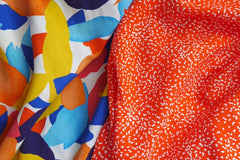SEWING WITH VISCOSE FABRICS

Drapery Slippery Viscose Fabrics!
Does the thought of sewing with slippery fabrics put you off?
When you see the words 'drapes well' used to describe a fabric, does that instantly make you shudder, and avoid the fabric like the plague?! Fear not, I promise not all the fabrics are slippery pieces of butter!
In my opinion, I find that the most fluid of viscose fabrics are the Viscose Challis fabrics. They hang beautifully as a garment, but can be slippery to cut out, and to sew together. However, with lots of pinning, sharp fine needles, and some time and patience, you can sew up some gorgeous garments with them. They definitely aren't the most tricky of fabrics I've sewn with!
If you are new to sewing with Viscose, I would recommend the fabrics that list Viscose on its own, as a plain weave, or a Viscose Poplin. Viscose fabrics from Lise Tailor, Atelier Brunette, or Viscose Poplins from My Dress Made are wonderful starting points for sewing with Viscose. They still have some drape, but also have stability within its structure, making them much more stable to sew and work with.
Viscose Twills and Viscose Crepes and both beautiful fabrics, but sometimes can be silky soft and therefore more slippery to work with than that of a plain Viscose.
Examples of good stable Viscose fabrics to work with first are:
- Lise Tailor Mandarine EcoVero Viscose
- Lise Tailor Peony Viscose
- Atelier Brunette Granito Night EcoVero Viscose
- My Dress Made Aquarelle Viscose Poplin
- My Dress Made Dune Viscose Poplin
Viscose fabrics can make beautiful garments, free-flowing, and feeling sumptuously soft against the skin, so never be afraid to start learning with these fabrics, then as you gain more experience with handling drapey fabrics, you'll be sewing with the finest, silkiest fabrics in no time!
Tips to sewing with Viscose fabrics:
- Always pre-wash the fabrics prior to sewing, as they can often shrink with the first wash.
- Use a fine, sharp needle in your sewing machine.
- Make sure you have plenty of clean, flat surface space to cut out your fabric. At home, I generally use my carpeted floor for this, it is the biggest surface area I have, and helps to prevent the fabric slipping about too much when cutting. (But I do have to mindful about my back, trying to cut on the floor!!)
- Patience. Ample amount of this!
Never give yourself an unrealistic time limit when sewing a project. It just adds stress, unnecessary pressure, and you will not be able to enjoy the process!
Most importantly, ensure the Viscose fabrics you buy are made from wood pulp sourced via certified, managed forests. And with other certifications such as Lenzing EcoVero, and STeP by Oeko-Tex, you can be safe in the knowledge that the production of these fabrics have been under strong safety measures, whilst also looking after the planet.
If in a doubt with a fabric choice, please do get in touch with us via email at info@akindcloth.co.uk where we shall do our best to help you!
